
In the first article I wrote on this blog, I stated that Tanktics in 1978 was considered the “first single-player strategy game commercially sold“, which allowed me not to worry too much about precursors as my blog was in its infancy. Still, I mentioned a few earlier strategy games on mainframe, Empire (1977) of course but also a much earlier game : Civil War in 1968. Eventually, I covered the most influential precursors : Empire , Star Trek and Trek73, so you have read about the best. Now, you can read about the rest ; those games that would have been totally unnoticeable if they had not been among the first video games in history. Lower your expectations, none of them are great, or even good – but they were there when there was nothing else.
Civil War (1968)

Civil War is, according to my Internet research, the earliest video game that can possibly fit the scope of this blog. There were earlier games, certainly, there were even earlier wargames, but those were either :
- simulations to be used by the military, rather than games (for instance starting in 1948 the various Carmonette), or
- classical board games (starting according to Mobygames in 1951 with Nim and Checkers) and as such not within the scope of that blog, or
- the unique case of the fascinating Darwin in 1961, multiplayer only. It stretches the definition of a wargame, but it is too interesting not to mention,
As I write this article, this leaves Civil War as the first wargame-adjacent single-player computer game that survived in memory.
For the AAR, I am going to use the version you can find on Archive.org’s Vintage Basic Games collection, there are some differences with the original version, but they are minor.
In Civil War, the player takes command of the Confederate or the Union army in one of 14 battles of the US Civil War :

“Takes command” may be overselling it, the player has only two inputs :
- How to distribute cash between food, salary and ammo,
- Which offensive or defensive strategy to choose,
The Data-Driven Gamer had done some code analysis of Civil War in the comment section of an unrelated article a while ago, and I used this as a basis of my strategy. Initially, it did not work out :

Losing Bull’s Run as the Confederates when historically the Union retreated hurt my pride, but things went better overall for the following battles as I adjusted my strategy and learned to use artillery every time I could :
- First Bull’s Run : Union victory
- Shiloh : Confederate victory
- Seven Days : Union victory
- Second Bull’s Run : Confederate victory
- Antietam : Confederate victory
- Fredericksburg : Confederate victory
- Murfreesboro : Union victory
- Chancellorsville : Confederate victory
- Vicksburg : Confederate victory
- Gettysburg : Confederate victory
- Chickamauga : Confederate victory
- Chattanooga : Union victory, absolute Confederate disaster
- Spotsylvania : Union victory
- Atlanta : Union victory
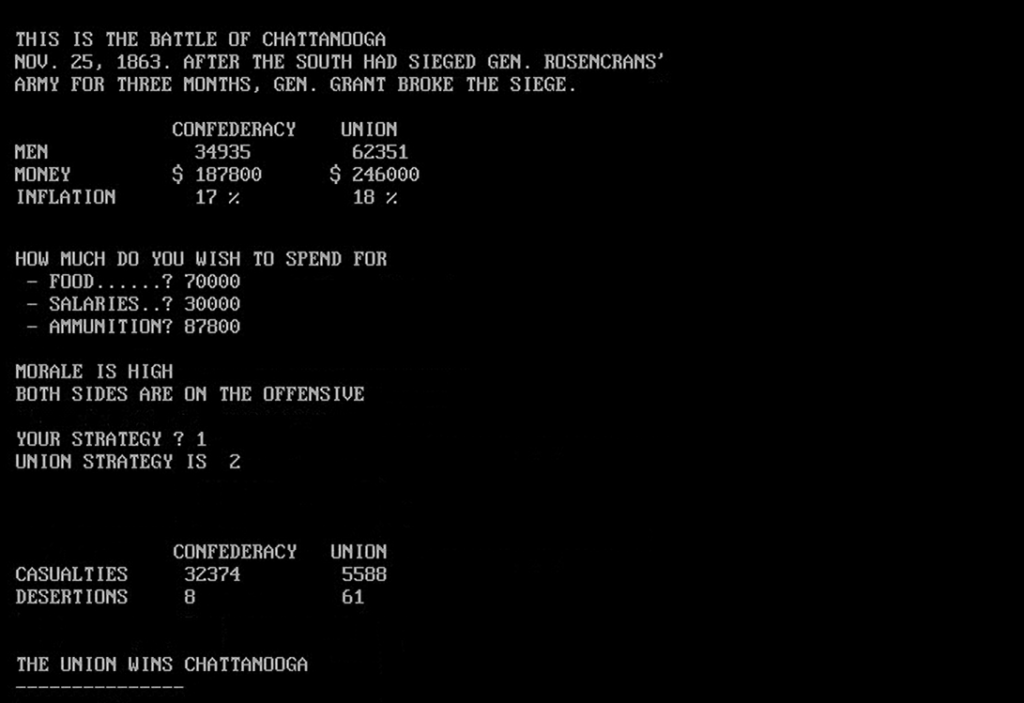
Unfortunately, every battle is independent – they can be played in any order – so there is no result for the campaign. With 8 victories and 6 defeats, I am going to chalk this as a victory. It is not like there would be a battle of Atlanta if the Confederates had won Shiloh, Antietam and Gettysburg.
Civil War was coded by three students about which nothing is known. The game was saved from oblivion by David Ahl’s 101 Basic Computer Games in 1973 (the same book that did so much for Star Trek) and after that ported on various platforms. The initial version of the game was one page long and even simpler than the one I played (it was solitaire only and the battles had to be played in order) but included a final tally after the 14th battle.
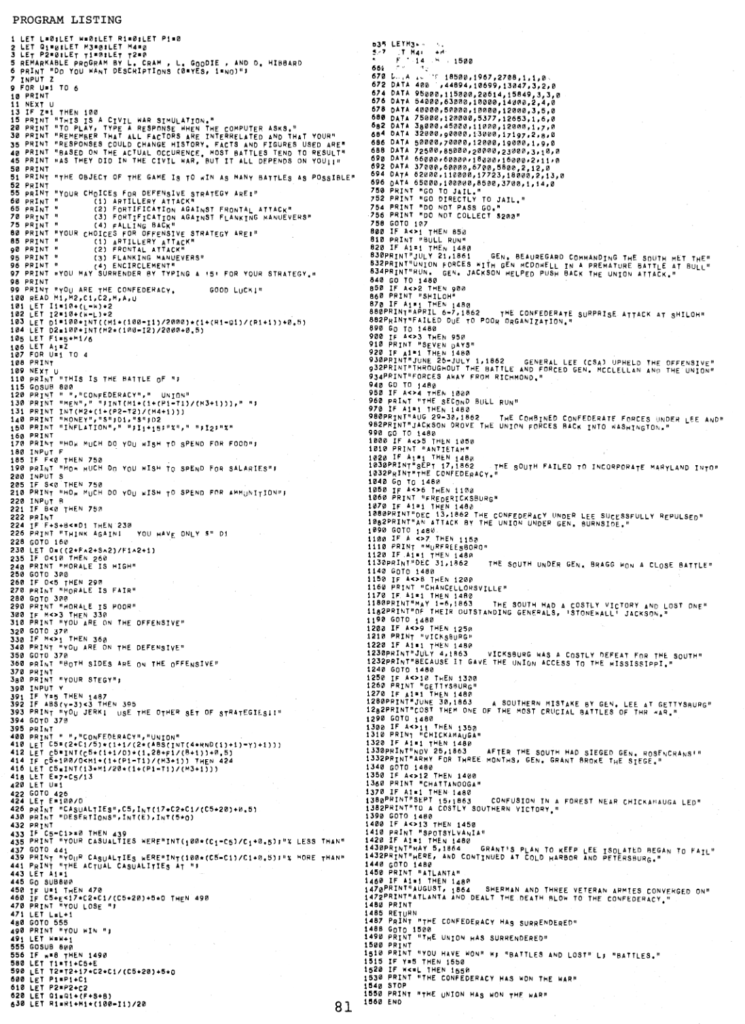
Not a good game, barely a wargame, but now covered !
High Noon (1970)
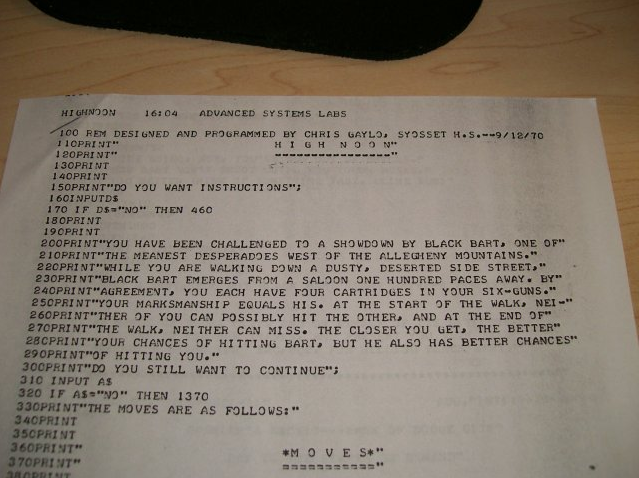
If Civil War is the distant precursor of computer strategy games, High Noon is the precursor of tactical games, as it pits the player again a gunslinger called Black Bart in 1889.
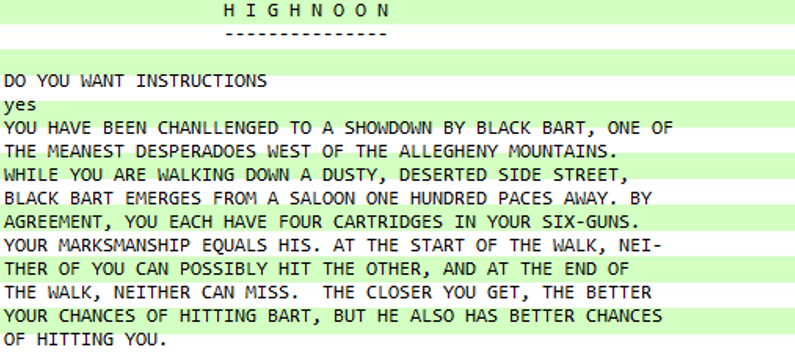
I am going to play the version ported by s1axter. As you can see, it emulates the teletype look.
High Noon is fairly simple, with only 6 options every turn :

ADVANCE, STAND STILL and FIRE are obvious. JUMP BEHIND WATERING TROUGH acts as a sort of “defend” option. GIVE UP and TURN TAIL AND RUN both end the game :
- if you give up Black Bart asks you to leave and never come back – you can accept or refuse, and if you resume the duel resumes
- if you run away Black Bart will shoot you. If you run fast enough, he will miss, else he will shoot you once in the back and the rest of his bullets, to quote the game “in your a**“. That’s if Black Bart has any bullets left, if not he will powerlessly throw his pistol at you.
Anyway, I stood my ground, and that’s how the duel went :
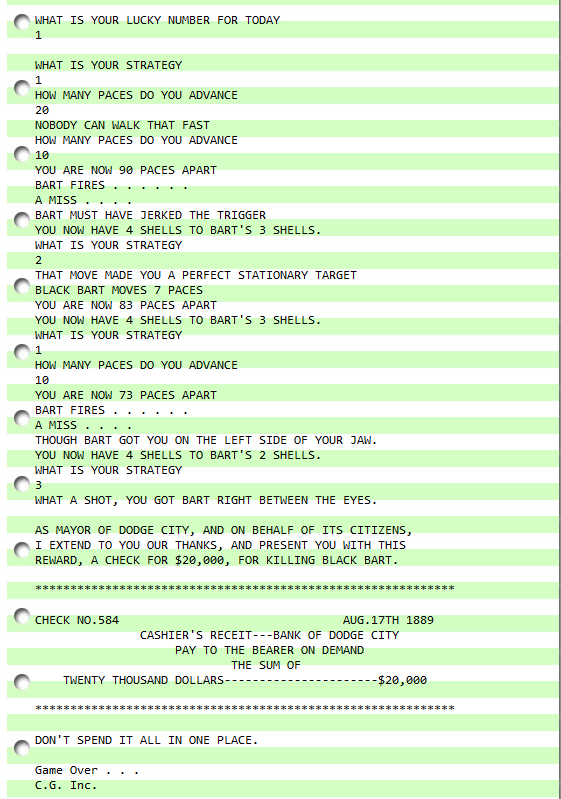
Black Bart is dead, and I am richer by $20 000, which apparently is around $600 000 in 2022. Nice.
High Noon is a very simple game, but it has real risk-vs-rewards decisions and as such I believe it is the best game of today’s article. But as it was not part of David Ahl’s 101 basic games, it was all but forgotten until a chance discovery of the source code by s1axter in 2007.
All the information I have comes from s1axter’s site. The site has not been updated for more than 10 years so I will copy it in full :
Highnoon is a BASIC game developed by a student from Syosset High School, NY in early 1970 on a timeshared computer system. […]
The creator recalls Highnoon was written on a timeshared system leased by Syosset High Scool from ‘Call-a-computer’ company (Later named Advanced Systems Labs) on Long Island, NY. The program is written in early BASIC and is less than 4 pages printed out. Development was all done via teletype terminal dialed into the server with a maximum user storage of 6.4K. Due to the limited persistent storage, other programs including Highnoon were transfered to paper punch tape off the mainframe. The author still has a copy of the binary program file and an ASCII print out of the code.
Highnoon was a popular game on the Call-A-Computer system and the compiled version was included as a system wide game by administrators.
In early 2007 I discovered the printed out BASIC code and set to making a web based emulation of the code. An initial version of the web adaptation of this game can be played here at myBitBox. The web based version of the game uses javascript to minic the typing of a teletype.
And now, let’s move to a much worse game :
War (1973 or earlier)

Early game developers were not very creative, and many early mainframe games were named “Star Trek“, “Empire” or, it turns out, ‘War’. Most of the early games called War are of no interest to me (for instance the first one in 1970 was a card game), but one, also called War-2 or Combat, sort of stands out as maybe a distant great-uncle to computer wargames. The great-uncle your parents don’t want you to meet.
The game starts on a prompt to distribute your 72 000 men between your ground forces, navy and air force :
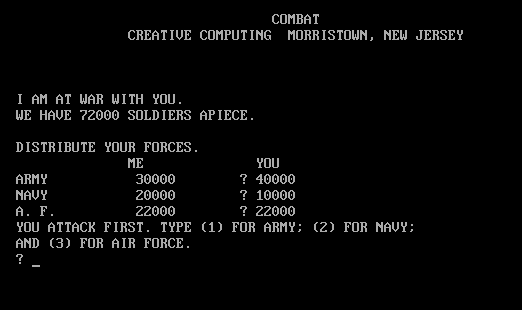
After that, you have two rounds of attack, with a report at the end of each one. For each attack, you specify which of the three branches of your troops attack, and how many men you send.
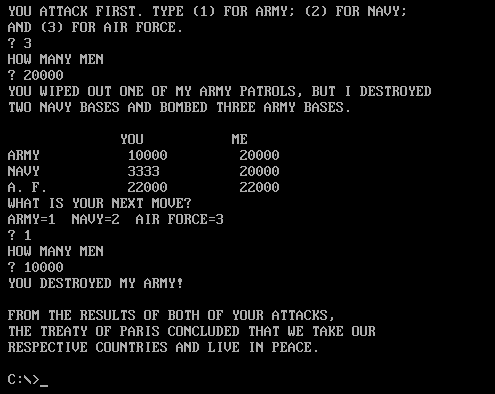
That’s it. It is one of those games that survived because it was lucky enough to be picked by David Ahl’s 1973 book of BASIC games, where the list takes half a page :
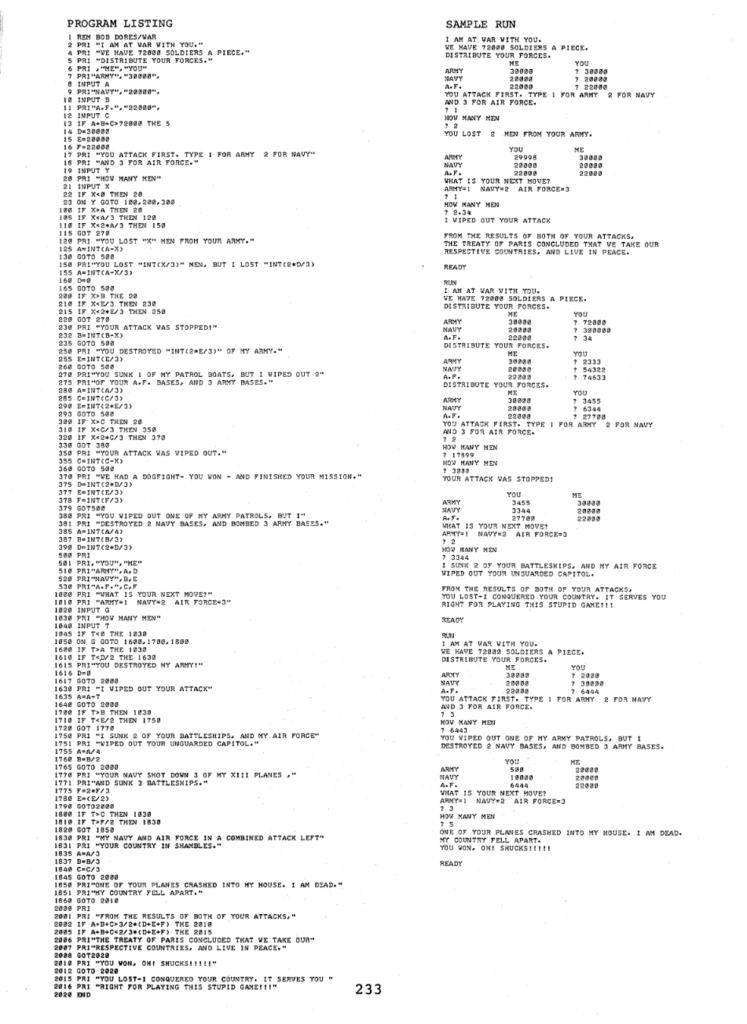
Deepspace (1975 or earlier)
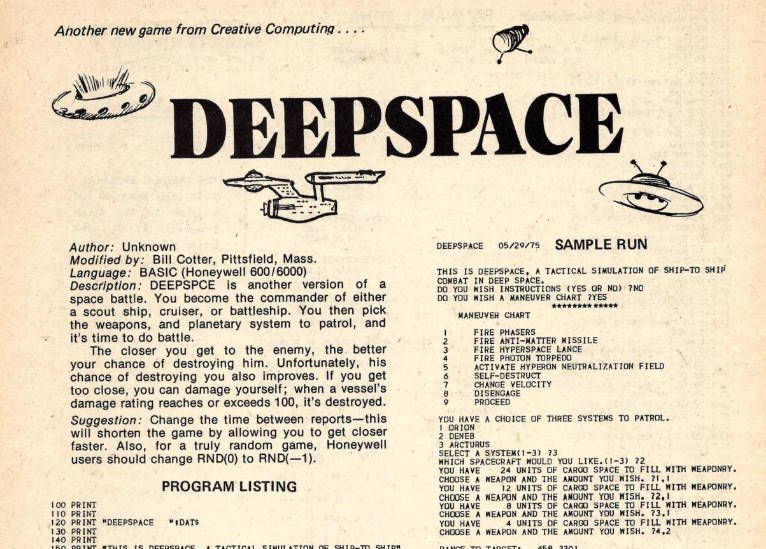
Deepspace is a Trek73-lite first published as a listing in the March-April 1976 issue of Creative Computing, which stated the language is BASIC for Honeywell 600/6000 (a mainframe computer). The “sample play” attached to the listing refers May 1975, so the game is from that date at the very latest. Unfortunately, the author is unknown. Again, I am going to use the archive.org port, this time “modernized” with pretty colours :

What makes this game slightly different from your usual Trek73-clone is that you build your own ship, or at least you pick a ship and choose what kind of ordonnance it carries :

So I picked a cruiser and mounted 1 phaser bank and 3 anti-matter missiles ! After that, I was offered to patrol Orion, Deneb or Arcturus. I went for Deneb because I remember the system from Reach for the Stars.
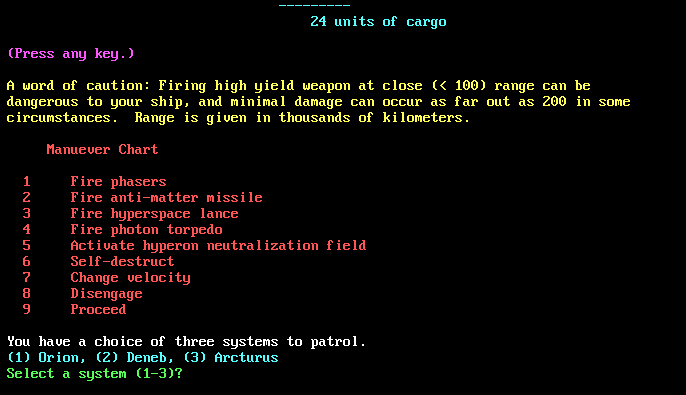
After having built the ship, the enemy appears at a certain range and relative velocity. It is unwise to shoot the missiles immediately, as the efficiency of all weapons quickly decreases with range. Initially, I hold my fire and approach.
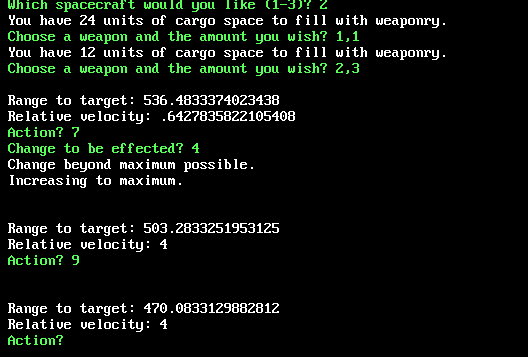
Once I feel I am close enough, I send all my missiles at the target, dealing massive damage.
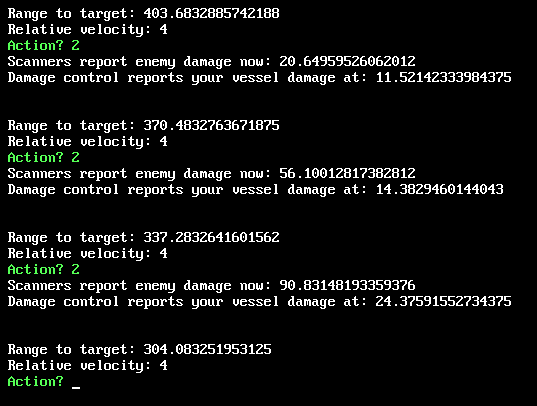
My opponent only has 9% of HP left, so I feel like I have this in the bag. Unfortunately, my opponent still has its own missiles. I am quickly brought to 68% damage and then 96% damage, before mutual destruction :
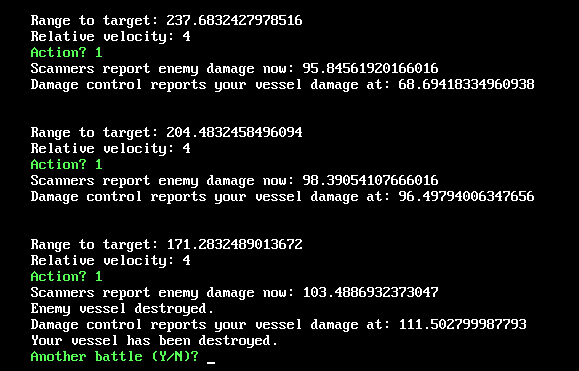
DeepSpace is not a great game, but I can’t say I was bored in the few minutes I played it.
That’s all for the “minor” mainframe games I could find so far.
Again, this article does not showcase the best capabilities of mainframe computers, in particular how good they were for early multiplayer games (for instance the many mainframe games called Empire covered by the Data Driven Gamer, but also RPGs, many of them). In addition, I did not cover the many Star Trek or Trek73 clones, most of which have disappeared. If you find any non-clone wargame-adjacent games for mainframe I have not covered, please tell me and I will add them to this article !